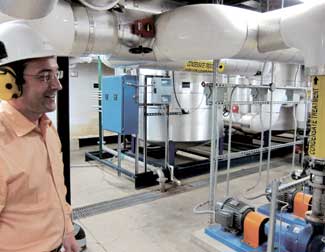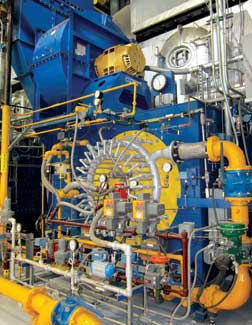Carrillo Street Steam Plant Is One of Cleanest University Heating Plants in Nation
As one of the biggest steps Pitt has made toward reducing its carbon footprint, the Carrillo Street Steam Plant seems deceptively subtle. The low-slung building behind Trees Hall on the University’s Upper Campus houses six towering, high-efficiency boilers connected to most of Pitt’s and UPMC’s buildings in Oakland via a tangle of pipes, tubes, and mammoth water purifiers—a roughly $33 million system that stands as one of the cleanest university heating plants in the United States.
 Above: Carrillo Street Steam Plant manager Marian Gagu stands before rows of industrial purifiers that monitor and control the pH balance of water heading into the boilers.
Above: Carrillo Street Steam Plant manager Marian Gagu stands before rows of industrial purifiers that monitor and control the pH balance of water heading into the boilers. The Carrillo Street plant converts an average of 4 million to 20 million gallons of water each month into the steam, depending on the season—nearly 42 million pounds worth in May 2011—used for heat, hot water, hospital sterilization, and humidity control. The plant serves about half of the Pitt/UPMC building load with the rest expected to be folded into the system in the fall of 2013 after Pitt/UPMC’s agreement with the Bellefield Boiler Plant in Panther Hollow expires.
While the particulars of steam production might not wow the green-minded, the environmental virtue of the Carrillo Street plant lies in how little exhaust and wastewater results from a facility that is immense in every other respect. Linking the full Pitt/UPMC production to the plant is expected to reduce Pitt/UPMC’s annual carbon dioxide emissions by 48,000 metric tons, nearly half of the 2008 baseline steam-related CO2 emissions.
Central to the plant are six boilers heated with the latest in high-efficiency burners. When Pitt began constructing the steam plant, the Allegheny County Health Department required the University to use the best-available technology to control emissions, explained Marian Gagu, the Carrillo Street plant manager and seasoned steam plant engineer. Emission of nitrogen oxide (NOx)—the toxic byproduct of high-temperature combustion that leads to smog and acid rain—was capped at the ultra-low level of nine parts per million. The industry norm for nitrogen oxide emission, Gagu said, is a comparatively lofty 30 parts per million or higher. In short, the Carrillo Street plant was selected as a model for constructing low-pollution steam plants, said Laura Zullo, senior manager of energy initiatives for Pitt Facilities Management.
Each boiler is a two-story behemoth with a series of pipes and gauges running along all 50-feet of its length. Automated controls that can be monitored on the plant floor and in a central control booth keep the boilers’ combustion air/fuel mix ratio very precise, Gagu said—any small deviation of the air/fuel ratio can greatly impact the efficiency of the boilers, causing a reduction in the amount of energy that can be produced per unit of fuel.
A disproportionately small observation window on each boiler shows a large spiral-shaped flame that keeps the internal temperature within the toasty range of 1,200 to 1,300 degrees Fahrenheit. That kind of heat needs a lot of natural gas: The two boilers operated during the warm month of May consumed 47,000 cubic feet of gas. (Diesel fuel can be used as a backup for emergencies.)
 Each of the six massive Carrillo Street boilers transforms roughly 14,000 gallons of water per hour into 115,000 pounds of steam.
Each of the six massive Carrillo Street boilers transforms roughly 14,000 gallons of water per hour into 115,000 pounds of steam.Yet, the high-efficiency burners and tightly controlled combustion ensure that more than 85 percent of the heating energy from the incoming gas is transformed into steam heating energy, keeping the boilers within the NOx-emission limit of nine parts per million. In order to achieve these ultra-low emissions, a flue gas recirculation system funnels exhaust from the boilers back into the burners to incinerate residual particulates and reduce the waste being released into the air, Gagu said.
On the other end of the elemental spectrum, water at the plant also is treated as a resource to be conserved. When in operation, each boiler transforms approximately 14,000 gallons of water per hour into steam. Eighty percent or more of the water remains after each cycle, or after steam is produced, piped across the University and hospital campus, and returned to the plant as condensate (water).
The returned condensate (which is pumped back from across campus) is mixed with fresh water from the municipal supply—water that first undergoes a five-step reverse-osmosis cleaning process to remove particulates and microorganisms, Gagu said. Beneath the main boiler room, rows of industrial purifiers monitor and control the pH balance of the make-up water and equipment performance is checked by plant operators during each shift. Three massive deaerator tanks also remove oxygen from the feedwater to protect the boilers and further improve system performance.
The sharp eye kept on water purity not only preserves the equipment, but also substantially reduces boiler maintenance costs and downtime, Gagu said. This diligence also closes the sustainable loop of the Carrillo Street plant, one built to generate the heat Pitt/UPMC needs while burning through as few resources as possible.
Other Stories From This Issue
On the Freedom Road

Follow a group of Pitt students on the Returning to the Roots of Civil Rights bus tour, a nine-day, 2,300-mile journey crisscrossing five states.
Day 1: The Awakening
Day 2: Deep Impressions
Day 3: Music, Montgomery, and More
Day 4: Looking Back, Looking Forward
Day 5: Learning to Remember
Day 6: The Mountaintop
Day 7: Slavery and Beyond
Day 8: Lessons to Bring Home
Day 9: Final Lessons

